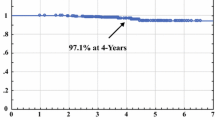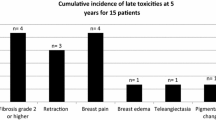Abstract
Purpose
External beam radiotherapy (EBRT) after conservative surgery for early breast cancer requires 5–7 weeks. For elderly patients and those distant from an RT center, attending for EBRT may be difficult or impossible. We investigated local toxicity, cosmetic outcomes, and quality of life in a new breast irradiation technique—intraoperative avidination for radionuclide therapy (IART)—in which avidin is administered to the tumor bed and 90Y-labelled biotin later administered intravenously to bind the avidin and provide irradiation. Reduced duration EBRT (40 Gy) is given subsequently.
Methods
After surgery, 50 (ten patients), 100 (15 patients) or 150 mg (ten patients) of avidin was injected into the tumor bed. After 12-24 h, 3.7 GBq 90Y-biotin (beta source for therapeutic effect) plus 185 MBq 111In-biotin (gamma source for imaging and dosimetry) was infused slowly. Whole-body scintigraphy and SPECT/CT images were taken for up to 30 h. Shortened EBRT started 4 weeks later. Local toxicity was assessed by RTOG scale; quality of life was assessed by EORTC QOL-30.
Results
Of 35 patients recruited (mean age 63 years; range 42–74) 32 received IART plus EBRT. 100 mg avidin provided 19.5 ± 4.0 Gy to the tumor bed and was considered the optimum dose. No side-effects of avidin or 90Y-biotin occurred, with no hematological or local toxicity. Local G3 toxicity occurred in 3/32 patients during EBRT. IART plus EBRT was well accepted, with good cosmetic outcomes and maintained quality of life.
Conclusions
IART plus reduced EBRT can accelerate irradiation after conservative breast surgery.



Similar content being viewed by others
References
Luini A, Gatti G, Galimberti V, Zurrida S, Intra M, Gentilini O, et al. Conservative treatment of breast cancer: its evolution. Breast Cancer Res Treat. 2005;94:195–8.
Veronesi U, Cascinelli N, Mariani L, Greco M, Sacozzi R, Luini A, et al. Twenty-year follow-up of a randomized study comparing breast-conservative surgery with radical mastectomy for early breast cancer. N Eng J Med. 2002;347:1227–32.
Veronesi U, Luini A, Galimberti V, Zurrida S. Conservation approaches for the management of stage I/II carcinoma of the breast: Milan Cancer Institute trials. World J Surg. 1994;18:70–5.
Morrow M, Strom EA, Basset LW, Dershaw DD, Fowble B, Giuliano A, et al. American College of Radiology; American College of Surgeons; Society of Surgical Oncology; College of American Pathology. Standard for breast conservation therapy in the management of invasive breast carcinoma. CA Cancer J Clin. 2002;52:277–300.
Athas WF, Adams-Cameron M, Hunt WC, Amir-Fazli A, Key CR. Travel distance to radiation therapy and receipt of radiotherapy following breast-conserving surgery. J Natl Cancer Inst. 2000;92:269–71.
Voti L, Richardson LC, Reis IM, Fleming LE, Mackinnon J, Coebergh JW. Treatment of local breast carcinoma in Florida: the role of the distance to radiation therapy facilities. Cancer. 2006;106(1):201–7.
Levitt SH, Aeppli DM, Nierengarten ME. The impact of radiation on early breast carcinoma. Cancer. 1996;75:1035–42.
Veronesi U, Orecchia R, Luini A, Galimberti V, Gatti G, Intra M, et al. Full-dose intraoperative radiotherapy with electrons during breast-conserving surgery: experience with 590 cases. Ann Surg. 2005;242:101–6.
Vaidya JS, Tobias JS, Baum M, Wenz F, Kraus-Tiefenbacher U, D’Souza D, et al. TARGeted Intraoperative radiotherapy (TARGIT): an innovative approach to partial-breast irradiation. Semin Radiat Oncol. 2005;15:84–91.
Vicini FA, Baglan KL, Kestin LL, Mitchell C, Chen PY, Frazier RC, et al. Accelerated treatment of breast cancer. J Clin Oncol. 2001;19:1993–2001.
Paganelli G, Bartolomei M, Ferrari M, Cremonesi M, Broggi G, Maira G, et al. Pre-targeted locoregional radioimmunotherapy with 90Y-biotin in glioma patients: phase I study and preliminary therapeutic results. Cancer Biother Radiopharm. 2001;16:227–35.
Goldenberg DM, Sharkey RM, Paganelli G, Barbet J, Chatal JF. Antibody pretargeting advances cancer radioimmunodetection and radioimmunotherapy. J Clin Oncol. 2006;24:823–34.
Bartolomei M, Mazzetta C, Handkiewicz-Junak D, Bodei L, Rocca P, Grana C, et al. Combined treatment of glioblastoma patients with locoregional pre-targeted 90Y-biotin radioimmunotherapy and temozolomide. Q J Nucl Med Mol Imaging. 2004;48:220–8.
Chinol M, Paganelli G, Sudati F, Meares C, Fazio F. Biodistribution in tumour-bearing mice of two 90Y-labelled biotins using three-step tumour targeting. Nucl Med Commun. 1997;18:176–82.
Samuel A, Paganelli G, Chiesa R, Sudati F, Calvitto M, Melissano G, et al. Detection of prosthetic vascular graft infection using avidin/indium-111-biotin scintigraphy. J Nucl Med. 1996;37:55–61.
Lazzeri E, Manca M, Molea N, Marchetti S, Consoli V, Bodei L, et al. Clinical validation of the avidin/indium-111 biotin approach for imaging infection/inflammation in orthopaedic patients. Eur J Nucl Med. 1999;26:606–14.
Yao Z, Zhang M, Sakahara H, Saga T, Arano Y, Konishi J. Avidin targeting of intraperitoneal tumor xenografts. J Natl Cancer Inst. 1998;90:25–9.
Paganelli G, Ferrari M, Cremonesi M, De Cicco C, Galimberti V, Luini A, et al. IART®: intraoperative avidination for radionuclide treatment. A new way of partial breast irradiation. Breast. 2007;16:17–26.
Paganelli G, Ferrari M, Ravasi L, Cremonesi M, De Cicco C, Galimberti V, et al. Intraoperative avidination for radionuclide therapy: a prospective new development to accelerate radiotherapy in breast cancer. Clin Cancer Res. 2007;13:5646s–51s.
Dale R, Carabe-Fernandez A. The radiobiology of conventional radiotherapy and its application to radionuclide therapy. Cancer Biother Radiopharm. 2005;20(1):47.
Barone R, Borson-Chazot F, Valkema R, et al. Patient-specific dosimetry in predicting renal toxicity with 90Y-DOTATOC: relevance of kidney volume and dose rate in finding a dose-effect relationship. J Nucl Med. 2005;46:99–106S.
Cremonesi M, Ferrari M, Bodei L, Tosi G, Paganelli G. Dosimetry in peptide radionuclide receptor therapy: a review. J Nucl Med. 2006;47:1467–75.
Wessels BW, Konijnenberg MW, Dale RG, Breitz HB, Cremonesi M, Meredith RF, et al. MIRD pamphlet No. 20: the effect of model assumptions on kidney dosimetry and response—implications for radionuclide therapy. J Nucl Med. 2008;49:1884–99.
Baechler S, Hobbs RF, Prideaux AR, et al. Estimates of radiation-absorbed dose to kidneys in patients treated with 90Y-ibritumomab tiuxetan. Cancer Biother Radiopharm. 2008;23(5):633–9.
Chinol M, Ferrari M. Methods to reduce radiation exposure to personnel during radiolabelling and infusion. In: Chinol M, Paganelli G, editors. Radionuclide peptide of cancer therapy. New York, NY: Taylor & Francis Group; 2006. pp. 301–13.
Stabin MG, Sparks RB, Crowe E. OLINDA/EXM: the second-generation personal computer software for internal dose assessment in nuclear medicine. J Nucl Med. 2005;46:1023–7.
Rosenstein BS, Lymberis SC, Formenti SC. Biologic comparison of partial breast irradiation protocols. Int J Radiat Oncol Biol Phys. 2004;60:1393–1404.
Cox JD, Stetz J, Pajak TF. Toxicity criteria of the Radiation Therapy Oncology Group (RTOG) and the European Organization for Research and Treatment of Cancer (EORTC). Int J Radiat Oncol Biol Phys. 1995;31:1341–6.
Aaronson NK, Ahmedzai S, Bergman B, Bullinger M, Cull A, Duez NJ, et al. The European Organization for Research and Treatment of Cancer QLQC30: a quality-of-life instrument for use in international clinical trials in oncology. J Natl Cancer Inst. 1993;85:365–76.
Fayers PM, Aaronson NK, Bjordal K, et al. The EORTC QLQ-C30 scoring manual. 2nd ed. Brussels: European Organization for Research and Treatment of Cancer; 1999.
Bubb MO, Green F, Conradie JD, Tchernyshev B, Bayer EA, Wilchek M. Natural antibodies to avidin in human serum. Immunol Lett. 1993;35:277–80.
Dale GL, Gaddy P, Pikul FJ. Antibodies against biotinylated proteins are present in normal human serum. J Lab Clin Med. 1994;123:365–71.
Clarke M, Collins R, Darby S, Davies C, Elphinstone P, Evans E, et al. Early Breast Cancer Trialists′ Collaborative Group (EBCTCG). Effects of radiotherapy and of differences in the extent of surgery for early breast cancer on local recurrence and 15-year survival: an overview of the randomised trials. Lancet. 2005;366:2087–106.
Huang J, Barbera L, Brouwers M, Browman G, Mackillop WJ. Does delay in starting treatment affect the outcomes of radiotherapy? A systematic review. J Clin Oncol. 2003;21:555–63.
Mackillop WJ, Bates JH, O’Sullivan B, Withers HR. The effect of delay in treatment on local control by radiotherapy. Int J Radiat Oncol Biol Phys. 1996;34:243–50.
Arriagada R, Rutqvist LE, Mattsson A, Kramar A, Rotstein S. Adequate locoregional treatment for early breast cancer may prevent secondary dissemination. J Clin Oncol. 1995;13:2869–78.
Acknowledgements
This study was supported by grants from the Italian Association for Cancer Research (AIRC). The authors thank Don Ward for help with the English and Deborah Console for editing the manuscript.
Conflicts of interest
G. Paganelli is a consultant to Sigma-Tau SpA. R. De Santis receives salaries from Sigma-Tau SpA. All other authors declared that they have no conflicts of interest.
Author information
Authors and Affiliations
Corresponding author
Rights and permissions
About this article
Cite this article
Paganelli, G., De Cicco, C., Ferrari, M.E. et al. Intraoperative avidination for radionuclide treatment as a radiotherapy boost in breast cancer: results of a phase II study with 90Y-labeled biotin. Eur J Nucl Med Mol Imaging 37, 203–211 (2010). https://doi.org/10.1007/s00259-009-1260-4
Received:
Accepted:
Published:
Issue Date:
DOI: https://doi.org/10.1007/s00259-009-1260-4




